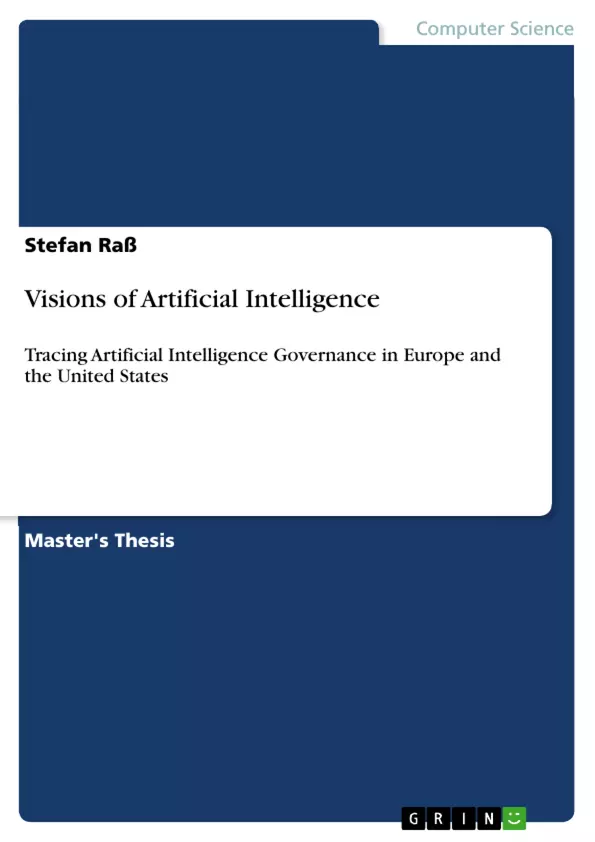Artificial Intelligence (AI) is often considered to be one of the defining technologies, which will be important in shaping the prosperity and power dynamics of the twenty-first century. In the last five years many governments around the world tried to implement policies that are intended to foster AI innovation in order to position themselves as leaders in a space that is thought to be the next global paradigm shift. Europe and the United States are thought leaders in this field and have published policy documents aimed at deliberating the future progress of AI and defining national policies or research strategies, which should serve as signposts for subsequent decisions. Research in Science, Technology Society (STS) studies has shown how sociotechnical imaginaries shape the ways emerging technologies are assessed, evaluated and regulated in differing political cultures. They inform the visions that make certain options possible, specific outcomes plausible and leave other avenues for policy dormant.
This thesis explores these imaginaries found in policy documents connected to regulatory attitudes towards AI and the social changes linked to this emerging technology in the United States and Europe along three dimensions: First, the dominant visions, images and ideals associated with the technological innovation in AI. Second, the expectations of benefits and risks projected onto AI. And third, the imagined role of governance of AI in the policy documents as well as how society is imagined to be part of the assessment, development and regulation. The thesis suggests, that AI offers a new and rich window into regulatory imaginaries in a specific moment of technological emergence. Some of the uncovered attitudes towards AI are reflected in imaginaries connected to previous technologies, however, AI constitutes a novel moment of emergence that links to unique attuites to regulating self-learning algorithmic intelligence.
Inhaltsverzeichnis (Table of Contents)
- Introduction
- State of the Art
- Artificial Intelligence
- Governing Emerging Technologies
- Imagining Emerging Technologies
- Research Question
- Methodological Considerations
- Structuring the Material
- Document Analysis
- Artificial Intelligence and the United States
- Preparing for the Future of Artificial Intelligence
- Technology and Innovation
- Benefits and Risks
- Governance and Citizens
- National Artificial Intelligence Research and Development Strategic Plan
- Technology and Innovation
- Benefits and Risks
- Governance and Citizens
- Artificial Intelligence, Automation, and the Economy
- Technology and Innovation
- Benefits and Risks
- Governance and Citizens
- Preparing for the Future of Artificial Intelligence
- Artificial Intelligence and the European Union
- Artificial Intelligence for Europe
- Technology and Innovation
- Benefits and Risks
- Governance and Citizens
- Coordinated Plan on Artificial Intelligence
- Technology and Innovation
- Benefits and Risks
- Governance and Citizens
- Ethics Guidelines for Trustworthy AI
- Technology and Innovation
- Benefits and Risks
- Governance and Citizens
- Artificial Intelligence for Europe
- American and European Visions of Artificial Intelligence
- Sustaining and Competing
- Risking and Balancing
- Avoiding and Managing
Zielsetzung und Themenschwerpunkte (Objectives and Key Themes)
This master's thesis examines the governance of artificial intelligence (AI) in Europe and the United States, analyzing the visions and expectations associated with this emerging technology in both regions. The work explores how these visions are articulated in official policy documents, highlighting the potential benefits and risks, the role of governance, and the envisaged participation of society in the assessment, development, and regulation of AI.
- Visions of AI in Europe and the United States
- Governance frameworks for emerging technologies
- Potential benefits and risks of AI
- The role of society in AI development and regulation
- Comparison of policy cultures and approaches to AI
Zusammenfassung der Kapitel (Chapter Summaries)
- Introduction: Provides an overview of the increasing reliance on computational algorithms in a digital age, highlighting AI's potential to influence societal and individual interactions. The introduction also discusses the utopian and dystopian visions surrounding AI and its impact on the future.
- State of the Art: Explores the origins and development of AI, focusing on the role of machine learning and its intersection with social sciences. This chapter lays the groundwork for understanding the current state of AI research and its societal implications.
- Artificial Intelligence and the United States: Examines the United States' approach to AI, analyzing key policy documents that outline their visions, strategies, and concerns. The chapter focuses on the National Artificial Intelligence Research and Development Strategic Plan and explores the intersections between AI, automation, and the economy.
- Artificial Intelligence and the European Union: Analyzes the European Union's perspective on AI, examining policy documents such as "Artificial Intelligence for Europe" and "Coordinated Plan on Artificial Intelligence". This chapter delves into the EU's focus on ethical considerations and the promotion of trustworthy AI.
- American and European Visions of Artificial Intelligence: Compares and contrasts the visions of AI held by the United States and Europe, identifying similarities and differences in their approaches to governance, risk assessment, and societal engagement.
Schlüsselwörter (Keywords)
Artificial intelligence (AI), emerging technologies, governance, policy analysis, United States, European Union, benefits and risks, societal impact, technological innovation, machine learning, deep learning, ethics, trust, policy cultures.
- Quote paper
- M.A. Stefan Raß (Author), 2019, Visions of Artificial Intelligence, Munich, GRIN Verlag, https://www.grin.com/document/1001872



